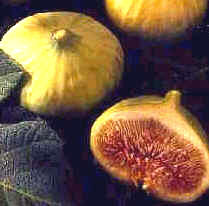|


 This
symbol denotes
disease resistance This
symbol denotes
disease resistance
"He who tends a fig
will eat its fruit."
Proverbs 27:18 (NIV) |
|
FIGS

The plant nursery has closed for retirement.
We thank you for your pratronage through the last 26 years.
Bill Ford is available for consultation and presentations.
Please feel free to use the following pages for reference.
Happy gardening!
Brown Turkey
 This
popular variety is one of the hardiest of all figs. The fruit are medium to large
and a mahogany brown with sweet red flesh. Excellent for fresh eating,
preserves and drying.
A naturally somewhat dwarfing plant. This
popular variety is one of the hardiest of all figs. The fruit are medium to large
and a mahogany brown with sweet red flesh. Excellent for fresh eating,
preserves and drying.
A naturally somewhat dwarfing plant.
Zones 6-10
Celeste
 Celeste
is also a very winter hardy and productive variety resistant to splitting and souring. The medium
size fruit ripens in early to mid summer to a purple-brown color. The very sweet peach colored flesh
is great for fresh eating, freezing, preserves and dried. Zones 6-10 Celeste
is also a very winter hardy and productive variety resistant to splitting and souring. The medium
size fruit ripens in early to mid summer to a purple-brown color. The very sweet peach colored flesh
is great for fresh eating, freezing, preserves and dried. Zones 6-10
Alma
 Alma, a
new fig variety
released by Texas, is a late season variety with very high fruit quality.
Fruit skin is golden yellow when ripe, and the golden flesh has an
excellent rich, sweet flavor great for fresh eating, cooking and
preserves. Very productive, even at a very early age, with moderately
vigorous growth. Alma is frost sensitive, especially as a young tree and
should be protected in winter. Zones 7b-10. Alma, a
new fig variety
released by Texas, is a late season variety with very high fruit quality.
Fruit skin is golden yellow when ripe, and the golden flesh has an
excellent rich, sweet flavor great for fresh eating, cooking and
preserves. Very productive, even at a very early age, with moderately
vigorous growth. Alma is frost sensitive, especially as a young tree and
should be protected in winter. Zones 7b-10.
|

